CPU water coolers, also known as AIO (all-in-one) coolers, come in various sizes, which are defined by the dimensions of the radiator and the fans it is designed to fit. The most common sizes are 120mm, 240mm, and 360mm, with some less common sizes like 140mm, 280mm, and 420mm. The size of the cooler you choose will depend on your specific needs, such as the cooling performance you require and the space available in your PC case.
Understanding AIO Cooler Sizes
When it comes to the dimensions of a 360mm AIO cooler, it is designed to work with three 120mm fans along one side, with a total fan size of 360mm (3 x 120 = 360). However, the actual dimensions of the radiator, such as its length, width, and thickness, will vary between manufacturers. It’s essential to check the actual dimensions of the radiator and the space limitations of your PC case before making a purchase.
120mm AIO Coolers
- Radiator Dimensions: Typically 120mm x 120mm x 27mm (Length x Width x Thickness)
- Designed to work with a single 120mm fan
- Suitable for smaller PC cases or systems with limited space
240mm AIO Coolers
- Radiator Dimensions: Typically 275mm x 120mm x 27mm (Length x Width x Thickness)
- Designed to work with two 120mm fans
- Offers better cooling performance than 120mm coolers
360mm AIO Coolers
- Radiator Dimensions: Typically 397mm x 120mm x 27mm (Length x Width x Thickness)
- Designed to work with three 120mm fans
- Provides the highest cooling performance among the common AIO sizes
Less Common Sizes
- 140mm AIO Coolers: Radiator Dimensions: 156mm x 140mm x 27mm
- 280mm AIO Coolers: Radiator Dimensions: 322mm x 140mm x 27mm
- 420mm AIO Coolers: Radiator Dimensions: 452mm x 140mm x 27mm
DIY CPU Water Cooling Components

When it comes to a DIY CPU water cooler, there are different components to consider, such as the radiator, pump, and fans. The standard size for normal water cooling pieces, including the radiator, pump, and RAM cooler, is called a G 1/4″ fitting, and they have all different size elbows and straight pieces that will comply with the G 1/4″ fitting.
Radiator Sizes
- Radiators come in a variety of sizes, including 120mm, 240mm, 360mm, and even larger options like 420mm and 480mm.
- The radiator size determines the number of fans it can accommodate and the overall cooling performance.
- Larger radiators generally provide better cooling, but they also require more space inside the PC case.
Pump and Reservoir
- The pump is responsible for circulating the coolant through the system.
- Pump sizes are typically measured in gallons per hour (GPH) or liters per hour (LPH).
- The reservoir holds the coolant and helps maintain the proper fluid level in the system.
- Reservoir sizes can range from 120ml to 1000ml or more, depending on the complexity of the water cooling setup.
Fittings and Tubing
- The standard size for water cooling fittings is G 1/4″, which is a thread size that ensures compatibility between different components.
- Tubing sizes commonly used in DIY water cooling are 1/2″ ID (inner diameter) and 3/8″ ID.
- Larger tubing sizes (3/4″ ID or 1″ ID) are sometimes used in high-performance systems, but they require larger fittings and can be more challenging to work with.
Choosing the Right CPU Water Cooler Size
When selecting a CPU water cooler, it’s essential to consider the following factors:
- Cooling Performance: Larger radiators and more fans generally provide better cooling performance, which is crucial for high-end CPUs or systems with significant overclocking.
- PC Case Compatibility: Ensure that the dimensions of the radiator and fans fit within the available space in your PC case. Measure the clearance carefully to avoid compatibility issues.
- Noise Level: Larger fans typically operate at lower RPMs, resulting in quieter operation compared to smaller fans running at higher speeds to achieve the same cooling performance.
- Budget: AIO coolers and custom water cooling components can vary significantly in price, so consider your budget when making a purchase decision.
By understanding the various dimensions and components of CPU water coolers, you can make an informed decision and select the best solution for your specific needs and system configuration.
